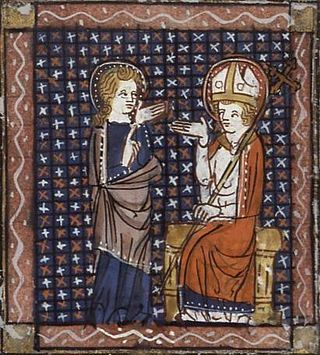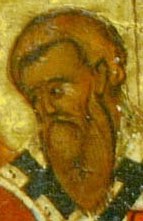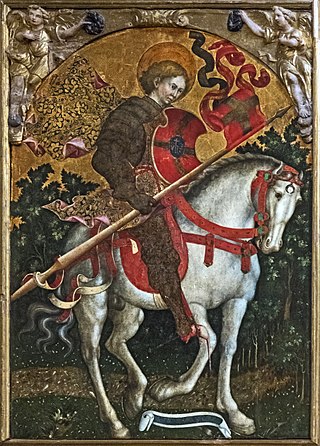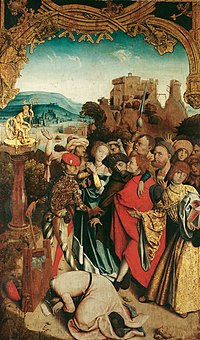
Hippolytus of Rome was a Bishop of Rome and one of the most important second–third centuries Christian theologians, whose provenance, identity and corpus remain elusive to scholars and historians. Suggested communities include Rome, Palestine, Egypt, Anatolia and other regions of the Middle East. The best historians of literature in the ancient church, including Eusebius and Jerome, openly confess they cannot name where Hippolytus the biblical commentator and theologian served in leadership. They had read his works but did not possess evidence of his community. Photios I of Constantinople describes him in his Bibliotheca as a disciple of Irenaeus, who was said to be a disciple of Polycarp, and from the context of this passage it is supposed that he suggested that Hippolytus so styled himself. This assertion is doubtful. One older theory asserts he came into conflict with the popes of his time and seems to have headed a schismatic group as a rival to the bishop of Rome, thus becoming an antipope. In this view, he opposed the Roman Popes who softened the penitential system to accommodate the large number of new pagan converts. However, he was reconciled to the Church before he died as a martyr.

Saint Valentine was a 3rd-century Roman saint, commemorated in Western Christianity on February 14 and in Eastern Orthodoxy on July 6. From the High Middle Ages, his feast day has been associated with a tradition of courtly love. He is also a patron saint of Terni, epilepsy and beekeepers. Saint Valentine was a clergyman – either a priest or a bishop – in the Roman Empire who ministered to persecuted Christians. He was martyred and his body buried on the Via Flaminia on February 14, which has been observed as the Feast of Saint Valentine since at least the eighth century.
An apostolic see is an episcopal see whose foundation is attributed to one or more of the apostles of Jesus or to one of their close associates. In Catholicism, the phrase "The Apostolic See" when capitalized refers specifically to the See of Rome.

Saint Nino was a woman who preached Christianity in the territory of the Kingdom of Iberia, in what is modern-day Georgia. Her preaching resulted in the Christianization of Iberia.

Sep. 10 - Eastern Orthodox liturgical calendar - Sep. 12

May 30 - Eastern Orthodox Church calendar - June 1

Maternus, also known as Maternus II, was the first known bishop of Cologne, reportedly also the third bishop of Trier, and founder of the diocese of Tongeren. He is venerated as a saint in the Catholic and Eastern Orthodox churches. The Basilica of Saint Maternus in Walcourt, Belgium was allegedly founded by him.

Saint Anastasia is a Christian saint and martyr who died at Sirmium in the Roman province of Pannonia Secunda. In the Eastern Orthodox Church, she is venerated as St. Anastasia the Pharmakolytria, i.e. "Deliverer from Potions". This epithet is also translated as "One who Cures (Wounds)" in Lampe's A Patristic Greek Lexicon.

Brice of Tours was a 5th-century Frankish bishop, the fourth Bishop of Tours, succeeding Martin of Tours in 397.

Pudens was an early Christian saint and martyr. He is mentioned as a layman of the Roman Church in 2 Timothy 4:21.

Saints Protus and Hyacinth were Christian martyrs during the persecution of Emperor Valerian. Protus' name is sometimes spelled Protatius, Proteus, Prothus, Prote, and Proto. His name was corrupted in England as Saint Pratt. Hyacinth is sometimes called by his Latin name Hyacinthus. The day of their annual commemoration is mentioned in the "Depositio Martyrum" on September 11, in the Chronograph of 354.

Eugenia of Rome was an early Christian Roman martyr whose feast day is celebrated on December 25 in the Roman Catholic Church, on December 24 in the Eastern Catholic Churches and Eastern Orthodox Church, and on January 23 in the Armenian Apostolic Church.

Podreča is a village on the right bank of the Sava River in the Municipality of Kranj in the Upper Carniola region of Slovenia.

Saint Chrysogonus is a saint and martyr of ancient Rome venerated by the Catholic Church and the Eastern Orthodox Church.

Saint Pothinus was the first bishop of Lyon and the first bishop of Gaul. He is first mentioned in a letter attributed to Irenaeus of Lyon. The letter was sent from the Christian communities of Lyon and Vienne to the Roman province of Asia.
In the early Christian Church, lapsi were apostates who renounced their faith under persecution by Roman authorities. The term refers to those who have lapsed or fallen away from their faith, only to return to it later.
Saints Castus and Emilius are venerated as saints and martyrs by the Eastern Orthodox and Roman Catholic Churches.
Saint Gal of Clermont was the sixteenth Bishop of Clermont, holding that see from 527 to 551. He shares a name with a later bishop of the diocese, who, though less illustrious than the first Gal, is also revered as a saint. Gal played an important role in the politics of the Church, as the Council of Clermont (535) was hosted under his episcopate. He was the uncle and teacher of Gregory of Tours.













